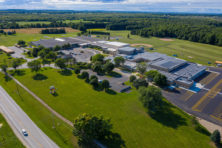Seawall Fund Is Start of Something Big
- Share
- Tweet
- Pin
- Share
Still reeling from the loss of 650 high-paying jobs when Dominion Resources Inc. was unable to find a buyer for the Kewaunee Nuclear Power Plant and shut the doors on May 7, 2013, the people of Kewaunee felt it was about time that something good happened for the city of 2,900 people.
“It has been a rough couple of years,” said City of Kewaunee Administrator Kyle Ellefson. “This community deserves some good news.”
That good news came when a proposal to grant $4.2 million to the city to rebuild its crumbling seawall made it intact through the state biennial budget.
Ellefson pointed out that the seawall project is more than a cosmetic fix.
“The walls are actually falling into the harbor,” he said. “With the water coming in behind the wall and undermining the soil, there are actually sinkholes. The lake is behind the wall in some areas. We can’t allow people to be in certain areas where it’s undermined because you could be walking and start sinking. It’s beyond a cosmetic upgrade that we’re doing.”
“This was a long process of gaining support, and a lot of people doing legwork and moving it through,” said Jennifer Brown of the Kewaunee County Economic Development Corp., which formed a strategic partnership with the city to find funds for the seawall repair and to secure a developer for a 3½-acre city-owned site on the waterfront.
“There were some very stressful moments waiting for the final budget,” said Tom Kleiman, owner of Accurate Marine in Kewaunee and a member of the board of the Kewaunee County Economic Development Corp. “There were some very nervous moments where we were concerned about all the work we did going up in smoke.”
Kleiman said securing funding for the seawall repair was the essential first step to the development of the 3½-acre site.
“If we’re going to attract a developer to come in there and invest in our community, we were going to have to give them a piece of property that is not only appealing but safe. No one was going to buy that piece of property with the seawall falling into the harbor,” he said. “It was more than a development opportunity for the area. It was a safety issue for residents and tourists as well. We literally had sinkholes big enough that kids could fall into. So we started looking at what we could do to get funding for it.”
The first roadblock the group of community-minded citizens found was that Kewaunee didn’t qualify for harbor assistance funding or any other state programs to help harbor communities.
“One of the issues with small harbor communities like ours, this is an issue statewide on Wisconsin shoreland,” Kleiman said. “There’s a harbor assistance program out there, but the criteria is such that little harbors don’t qualify. You have to ship so much commercial tonnage to qualify for the harbor assistance program fund. It became pretty clear that the only thing we could do is to get an ask in the state budget to get some help for Kewaunee. And that’s what we did.”
Kleiman said he and others involved gained a greater appreciation for the legislative process while trying to make the seawall funding happen.
“It was a really good process,” he said. “It was very interesting to see how things work in Madison and it was really refreshing to see how many good people there really are in Madison. When you talk to representatives around the state, there are a lot of good people trying to do good things, and not only for their area. When you can go down there and tell them what is going on, and they’re like, ‘Yeah, I get it. You guys really need some help.’ That’s how it’s supposed to work.”
They began by enlisting Rep. Joel Kitchens and Sen. Frank Lasee’s staff to get on board with the plan.
“Joel’s been a tremendous asset to Kewaunee County,” Kleiman said. “He worked very hard on this and we’re really grateful for his work. I know when we went down to Madison and talked to people, they all said, ‘Oh, yeah, Joel told us about this,’ or ‘Kitchen is in here all the time talking about this.’
“Then we started beating on doors in Madison and stating our case and letting legislators all over the state know what we were up against and why we needed help,” Kleiman said. “When you’re in Madison asking for money, the first thing they say is, ‘Why you? Why not every other county in the state of Wisconsin?’ We had a real need here. We had a lot of things that made us stand out to legislators and say, ‘You know what? They do need help.’ We had a definite program. We had a seawall that was literally falling into the harbor. Then we had the loss of the Dominion nuclear plant, which was a huge economic blow to our county. That was another thing that set us apart and made the timing of this more urgent.”
“I think sometimes it’s taken for granted how much work went into this,” said City Administrator Ellefson. “Mayor Blaha did a tremendous amount of work on this issue for eight years or more, back when it started to be an issue. And Tom Kleiman. They’ve really worked tirelessly on this.”
“It still seems surreal to me,” Kleiman said. “As I’m talking with you right now, I’m staring at the seawall. I have a picture in my mind of what it’s going to look like when it’s done. The nice thing about this, we’re not just repairing the infrastructure of the seawall. We put together a plan that is going to make that area attractive to development. It works in conjunction with the waterfront development plan that the city did back in 2005, which I was a part of. One of the things it called for is a boardwalk-type area or path to get foot traffic, for people to get out of their vehicles, enjoy the harbor and connect that with the downtown district and the Ahnapee trailhead. Really, the harbor is the hub of community in terms of people flow and business flow. Look at Sheboygan, what they’ve done down there. They started at the harbor and they keep working out from there. You drive down into that Sheboygan harbor area, it’s absolutely beautiful. People want to stop and get out and see what there is. That’s what we’re going to have to do in Kewaunee, too. Obviously not on that large of a scale, but that’s the blueprint. We’re not reinventing the wheel. We asked the state to help us help ourselves. It’s a very exciting time.”


